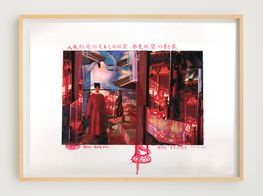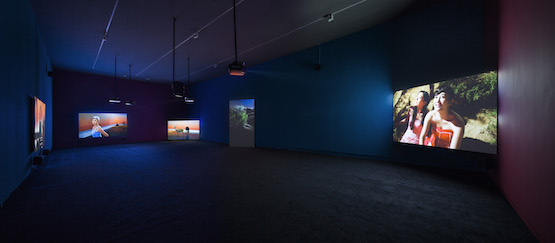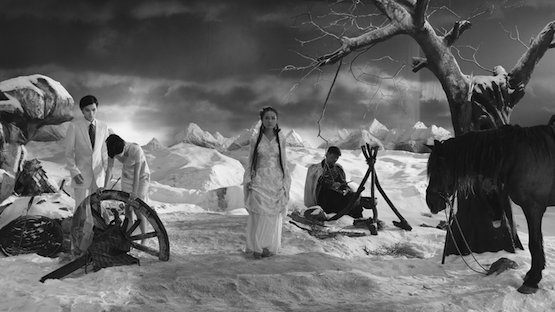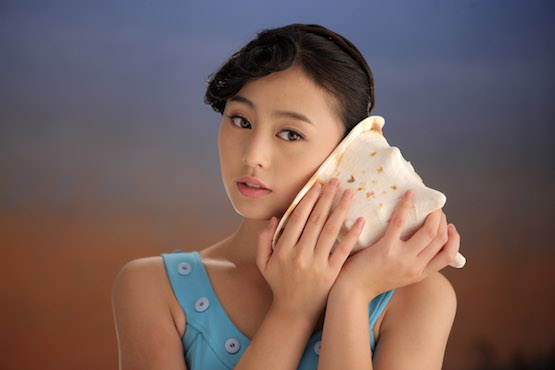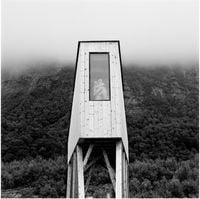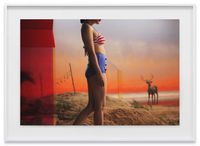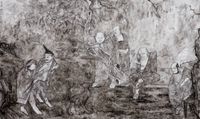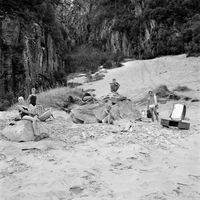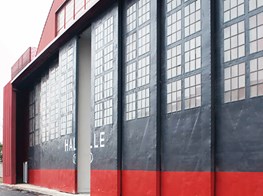Yang Fudong on Filmscapes
Yang Fudong, 2014. Photo: Mark Gambino
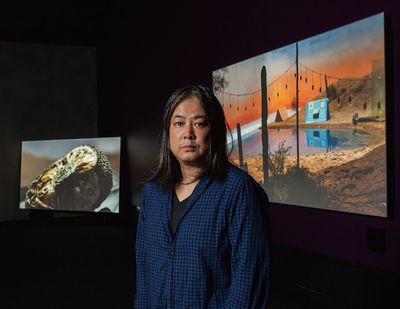
Yang Fudong, 2014. Photo: Mark Gambino
Lyrical, nostalgic and profoundly beautiful, Yang Fudong's photographs and multi-channel videos have immediately become iconic. Ocula spoke to Yang on the occasion of his new solo shows: Twin Tracks: Yang Fudong Solo Exhibition at the Yuz Museum in Shanghai (until 15 November 2015) and Yang Fudong: Filmscapes at Auckland Art Gallery Toi o Tāmaki (until 25 January 2016).
SGAfter showing in Australia and Europe, the China debut of The Colored Sky: New Women II recently opened at the Yuz Museum in Shanghai. What responses to the work have you received?
YFThe latest display of The Colored Sky: New Women II will be in the Auckland Art Gallery, which is also my first solo exhibition in New Zealand. I hope that my works can be seen by a wide audience. The audience themselves are probably the second director. Everyone has his or her own feeling and understanding when viewing the video. People are therefore editing either long or short versions of The Colored Sky: New Women II that belong only to themselves.
SGYou've said you feel a sense of artificiality looking at the colored sky. I think that feeling must be especially strong for someone going from Shanghai to Auckland (as it was for me coming from New Zealand and moving to China). Considering the content of your recent works, what have you noticed about different skies in different parts of the world and the different ways they're represented in paintings and on video?
YFWhen I was little, the teacher would use a spinning top painted with seven colours for an experiment. If you put it on the desk, and then spun it with your hand, the seven colours would vanish instantly and turn into the colour of white, which is very pure. Sometimes, being colourful is being pure, and that applies also to art. When we fly in an airplane above the sky, although there are a lot of chromatic things in the world, all that we can see are the white clouds.
SGYou decided against shooting The Colored Sky: New Women II in a natural setting, preferring to use a cinema set and stage lighting. Ma Liang, the Shanghai-based photographer, said surrealism is the realism of our time, and takes his visual language from theatre. The Nightman Cometh is more lyrical, evocative of a dream more than a real time or place. I wonder if you too feel like authenticity is somehow too diminished or too polluted to evoke directly?
YFSometimes I wonder if reality is real. Is what we see with our eyes real? It might be that dreams shorten distances, and what you imagine is closest to your heart. The artificial sets, stage lights and the performance of the actors are more likely to be the filter for real life.
SGYour shoots are largely unscripted because you say you want 'a sincerity and realness that can only happen in the moment,' but I understand that you do rehearse scenes. Can you talk more about your process working with the actors in your shoots? What are the most common directions you give?
YFNormally I already have a general sense in terms of how to make the work, the direction my heart expects to go. I communicate that with the actors, hoping that we could head in that direction. Sometimes the actors wouldn't really understand what I really want is for them to be natural and spontaneous. The selection of actors is really important—the right actors mean everything.
I want to try creating diverse 'art films', which should include traditional films.
SGFrom the black and white belle époque pictures of International Hotel to the old Shanghai set in The Fifth Night and the Kodachrome colour images in New Women II, you've built a bridge to the pre-People's Republic era through period costume and settings. Do you feel an absence or longing for the cinema that might have been made in China between 1950 and 1980?
YFEvery epoch has its own characteristics, and time contains both memory and existence. Sometimes, life doesn't need to replicate the life and memory of the past, but should instead search for and discover the taste for beauty and fun reminiscent of the past epoch, and try to turn them into works with qualities that are unique to this period of time.
SGThere's this duality in your works. They seem extremely superficial, while being richly allusive and referential: in New Women II, Munch's Scream, Botticelli's The Birth of Venus and Gauguin's Where Do We Come From? What Are We? Where Are We Going? have all been invoked. I'm reminded of Zhou Tiehai's airbrush portraits of '80s celebrities too. Is it important that your works operate on these two levels?
YFThe title of my solo exhibition in Yuz Museum, Shanghai comes from a very famous idiom in China, [Twin Tracks]. It roughly means that a chariot intending to go south is instead going northward. I have once said that sometimes life is like heading to the direction that is opposite to where you want to go. It represents an attitude to creating art; there might be many different options, but it's essential to judge and choose. It depends on the aesthetic taste of the artist as well as the sincerity and respect in his heart, even if the directions in creating artworks are different.
SGYou studied painting at the China Academy of Fine Art in Hangzhou before turning to film. Given the beauty of your compositions and your ostensible disinterest in dialogue and narrative, I wonder, are you a painter masquerading as a video maker?
YFI am happy to be a painter, if it's okay to call me that. It's only that still and video cameras have become my paint brushes. They are different media and materials that are more suitable to accomplish my thoughts.
SGThe Fifth Night is shot on the old Shanghai film set and displayed on seven screens arranged in a line, like a single scroll, or a roll of film frames. Like other works of yours, there's little narrative development or plot, though the images often hint at action that is about to happen, or has just happened. The use of multiple channels makes it seem as if prioritising one perspective or account would be presumptuous and misleading. Are you skeptical about narrative as a way we experience our own lives? Are we up to the job of writing and editing our own lives?
YFSince 2007, I've created so called 'space' films, which explore how to show video artworks in certain spaces. Sometimes I also call them 'three-dimensional' films. The Fifth Night is one of the 'space' films. It shows different scenes in a long scroll, creating a midnight poetry theatre. When watching the video, if the eyes of the audience are focused on the third screen, they're still be able to take a glimpse of the changes on other screens out of the corners of their eyes.
You can call them 'split vision films'. At the beginning of our conversation I said that the audience are the second director, they decide the way to view the film. Through their eyes, the space films are edited and would become unique to them, and I hope the films would become 'free cinema' that belongs to themselves.
SGYour crews have grown to the size of film crews. Do you have any desire to make a more conventional movie?
YFI want to try creating diverse 'art films', which should include traditional films, and I do hope that they could approximate what I imagine as 'free cinema' films.—[O]

